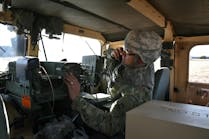WASHINGTON, 15 February 2005. A test of the U.S. missile defense system failed Monday when an interceptor missile did not launch from its island base in the Pacific Ocean, the military said. It was the second failure in two months for the experimental program.
A statement from the Missile Defense Agency said the cause of the failure was under investigation. A spokesman for the agency, Rick Lehner, said the early indications was that there was a malfunction with the ground support equipment at the test range on Kwajalein Island in the Marshall Islands, not with the missile interceptor itself.
For more information, see http://www.acq.osd.mil/mda/mdalink/html/mdalink.html.
If verified, that would be a relief for program officials because it would mean no new problems had been discovered with the missile. Previous failures of these high-profile, $85 million test launches have been regarded as significant setbacks by critics of the program.
In Monday's test, the interceptor missile was to target a mock ICBM fired from Kodiak Island, Alaska. The target missile launched at 1:22 a.m. Monday EST (0622GMT) without any problems, but the interceptor did not launch.
The previous test, on December 15, failed under almost identical circumstances. The target missile launched, but the interceptor did not. Military officials later blamed that failure on fault-tolerance software that was oversensitive to small errors in the flow of data between the missile and a flight computer. The software shut down the launch; officials said they would decrease the sensitivity in future launches.
Before the December 15 launch, it had been two years since a test. The program had gone five-for-eight in previous attempts to intercept a target.
No date for the next test has been announced. It is unclear how continued test failures would affect two experimental interceptor bases in Alaska and California.
Those two bases -- Fort Greely, Alaska, and Vandenberg Air Force Base, Calif. -- are positioned to oppose the threat of attack from North Korea. Both are still classified as experimental but, officials say, they could fire interceptors in an emergency.
The Pentagon has not declared those bases "operational," but officials say they would work anyway once certain mechanical blocks are removed from the interceptors themselves. Six interceptors are at the Alaska site, with two more in California as a backup. Up to 10 more will go into silos in Alaska this year, officials say.
-- By the Associated Press


